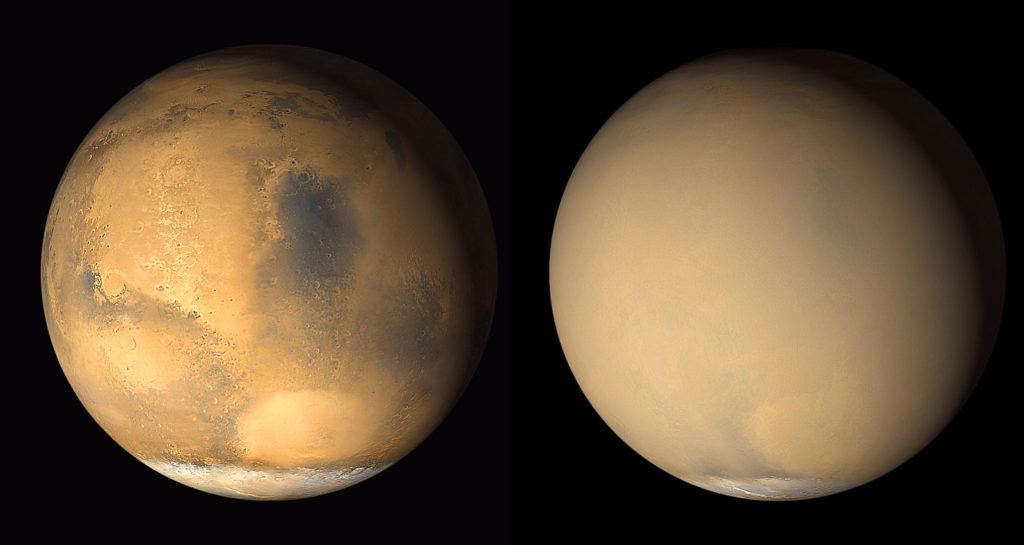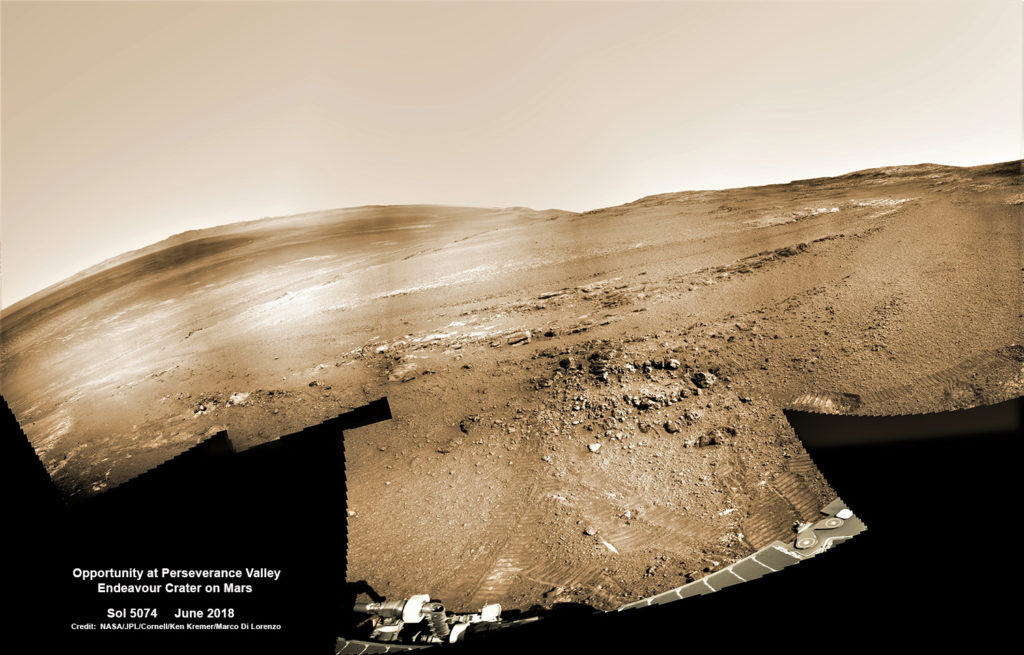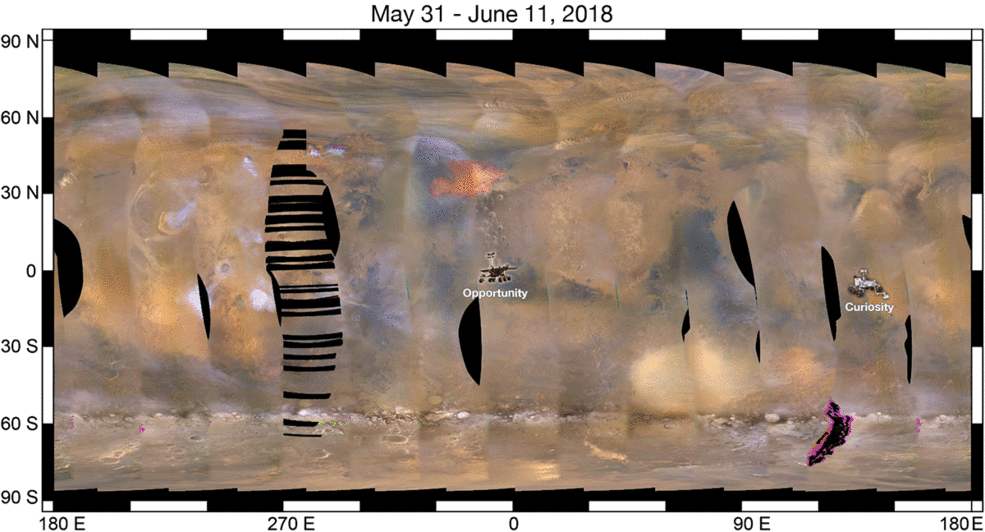FL – The escalating dust storm afflicting
the Red Planet that began in late May has now grown to a “planet-encircling” event NASA announced today, as the agency’s
long-lived Opportunity rover remains silent, starved of power from its life
giving solar arrays – fate unknown!
signs that the storm will clear anytime soon as it continues to grow in Martian magnitude.
morning, June 19, the Martian dust storm has grown in size and is now
officially a “planet-encircling” (or “global”) dust event,”
according to Bruce Cantor of Malin Space Science Systems, San Diego, who is
deputy principal investigator of the Mars Color Imager camera on board NASA’s
Mars Reconnaissance Orbiter, in a NASA statement released June 20.
of three orbiters are monitoring the dust storm daily with a suite of science
instruments streaming data back to researchers here on Earth for analysis.
“It’s anyone’s guess
how it will further develop, but it shows no sign of clearing,” NASA said in a
statement.
massive global Martian dust storm blotting out virtually all life-giving sunlight
has effectively turned day into night on frigid Mars, imperiling Opportunity’s survival
and forcing her to shut down all subsystems and go into sleep mode in a bid to
hang on for dear life – at a spot coincidentally called ‘Perseverance Valley.’
Opportunity rover, despite efforts to listen in case it’s coming out of sleep
during its fault window — the period of time when it attempts to communicate.”
June 10. The team listens regularly
every day, hoping the six wheeled robot will wake up. But its unlikely until the dust-choked skies
clear up sufficiently to power up the sleeping systems.
the rover’s long-term survivability in Mars’ extreme cold suggests
Opportunity’s electronics and batteries can stay warm enough to function.
Regardless, the project doesn’t expect to hear back from Opportunity until the
skies begin to clear over the rover. That doesn’t stop them from listening for
the rover every day.”
what Opportunity’ surroundings look like, be sure to check out our exclusive
rover mosaics showing her current view from Perseverance Valley and our route
map – created by the imaging team of Ken Kremer and Marco Di Lorenzo.
other operating Mars rover, the nuclear powered Curiosity Mars Science
Laboratory (MSL) vehicle located
on the other side of the planet remains unaffected – although the skies over her Gale
Crater landing site have darkened considerably.
unabated, including making measurements confirming the increasing dust levels,
while Opportunity remains in deep sleep unable to make any measurements or
communications of any kind.
measured by atmospheric opacity (tau) more than doubled this past weekend to 8 tau.
energy production to plummet.
the tau level was only 0.6.
“tau,” is now above 8.0 at Gale Crater — the highest tau the mission
has ever recorded. Tau was last measured near 11 over Opportunity, thick enough
that accurate measurements are no longer possible for Mars’ oldest active rover,”
NASA officials report.
storm status update NASA said the 2018 dust storm is “comparable in scale to a similar storm observed by
Viking I in 1977, but not as big as the 2007 storm that Opportunity previously
weathered. But it’s also different than the massive storms observed by Mariner
9 (1971-1972) and Mars Global Surveyor (2001). Those storms totally obscured
the planet’s surface, save for the peaks of Mars’ tallest volcanoes. The
current dust storm is more diffuse and patchy; it’s anyone’s guess how it will
further develop, but it shows no sign of clearing.”
in 2003, landed in 2004 and has been making breakthrough science and
exploration discoveries ever since during its utterly remarkable 14.5-year-long
overland trek across the 4th planet from the sun.
that it covered more than 15.8 million square miles (41 million square
kilometers) – about the area of North America and Russia combined.
that it effectively turned day into night for Opportunity, which is located
near the center of the storm, inside Mars’ Perseverance Valley.
powered Opportunity rover charges her batteries, instruments and heaters via
sunlight impinging on her solar arrays, No sunlight means no production of electrical power to run her systems and subsystems.
threatens Opportunity. We are concerned because there is no signal,” said John
Callas, Opportunity project
manager at NASA’s Jet Propulsion Laboratory, Pasadena, California, at a hastily
arranged NASA briefing for reporters on June 13.
spacecraft emergency on June 10 when solar energy production was only 22
watt-hours. Everything was turned off
except the master clock.”
black on Mars!”
current storm was “just 2 or 3 days away from becoming a planet encircling
event,” said Rich Zurek, chief scientist for the Mars
Program Office at NASA’s Jet Propulsion Laboratory in Pasadena, California.
Calles to comment about how long the storm will continue to intensify ? and how
long can the rover survive in the very low power mode weeks/months?
dust haze that is spreading over the planet and getting raised higher into the
atmosphere. That can lengthen depending on how long it takes for the storm to
clear,” Zurek told me.
alot worse – but it doesn’t matter because there is almost no sunlight reaching
the ground anyway. It’s a very dusty sky right now.”
that. That is one of the issues that we are trying to understand.”
where the dust areas stop being raised into the atmosphere and everything
begins to fall out. The winds are part of that and will eventually die down. And
when that happens – next week or two weeks from now – we don’t know,” Zurek
explained to Space UpClose.
predictions are that it will, then we can go any number of days,” Callas told
me.
warmest part of the year yet for the rover at this site.”
“In terms of the low power mode, well the rover actually
goes into that every day. We have a process we call deep sleep in which once we
are done with our activities for the day, we disconnect the batteries from the
rover and only the mission clock is connected. And so we have been deep
sleeping now for thousands of Sols.”
throughout the entire day, not just at night,” Callas replied to Space UpClose.
eroded western rim of the gigantic 22-km diameter (14 mi) impact crater named
Endeavour.
for “90 Sols” of operation, it is now enjoying its 15th year of
continuous operations on the frigid alien world.
ancient fluid-carved valley “possibly water-cut” that could hold groundbreaking
clues to the potential origin and evolution of life on Mars – if it ever
existed.
2018, long lived Opportunity has survived over 5120 Sols (or Martian days)
roving the harsh environment of the Red Planet.
228,771 images and traversed over 28.06 miles (45.16 kilometers) – more than a marathon.
Boeing, Lockheed Martin, Orbital ATK and more space and mission reports direct
from the Kennedy Space Center, Cape Canaveral Air Force Station, Florida and
Wallops Flight Facility, Virginia.
Stay tuned here for Ken’s continuing Earth and Planetary science and human
spaceflight news: www.kenkremer.com
–www.spaceupclose.com – twitter @ken_kremer – email: ken at kenkremer.com







